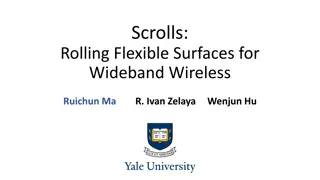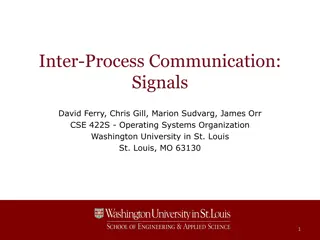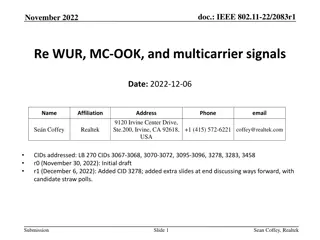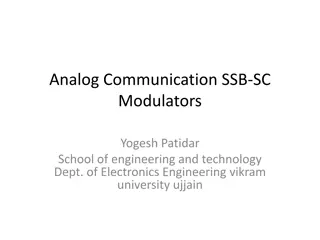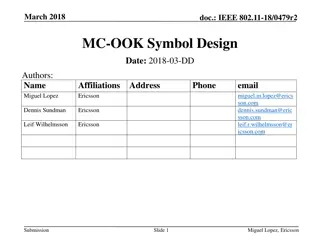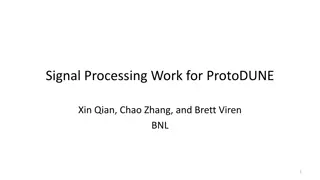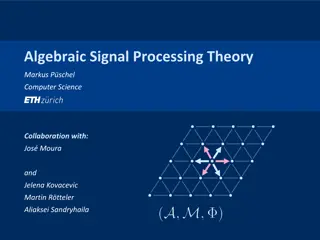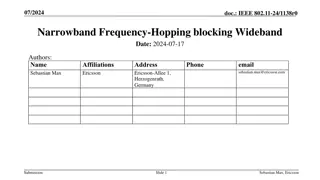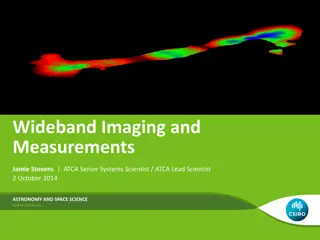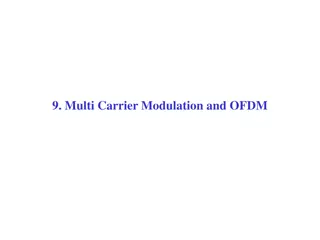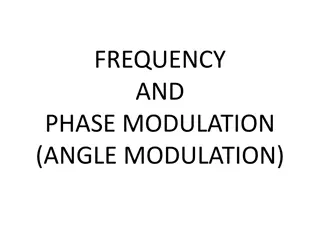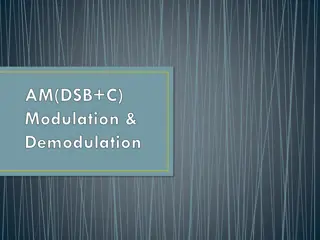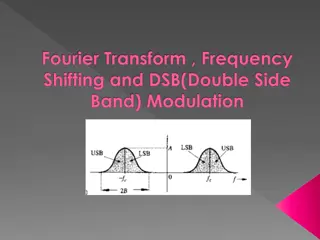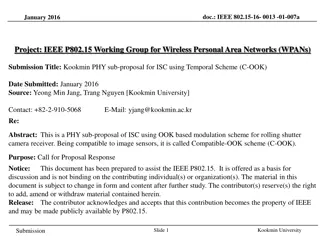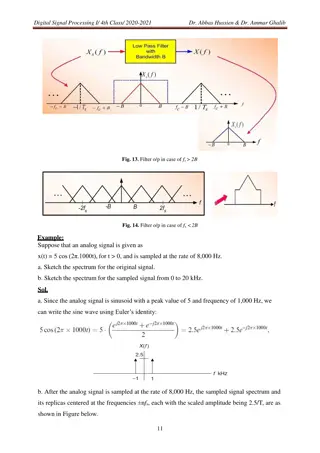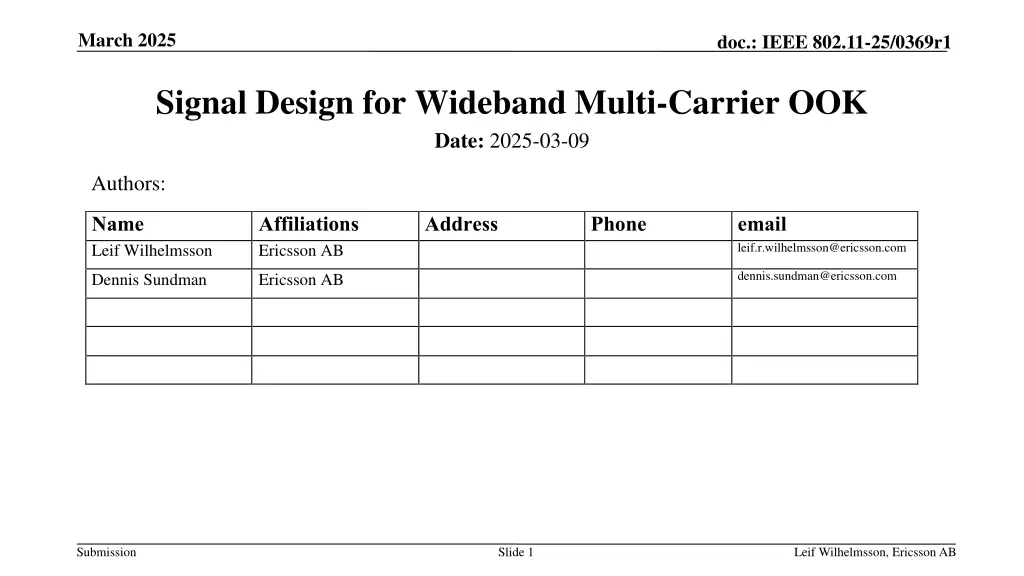
IEEE Signal Design for Wideband Multi-Carrier OOK
Explore the signal design for wideband multi-carrier on-off keying (OOK) technology in IEEE 802.11-25/0369r1 document. The discussion includes achieving large bandwidth for low data rates, frequency and time properties of the signal, and the search for a suitable OOK signal with high MAP and low PAPR. Join the conversation on optimizing signal performance for efficient communication.
Download Presentation

Please find below an Image/Link to download the presentation.
The content on the website is provided AS IS for your information and personal use only. It may not be sold, licensed, or shared on other websites without obtaining consent from the author. If you encounter any issues during the download, it is possible that the publisher has removed the file from their server.
You are allowed to download the files provided on this website for personal or commercial use, subject to the condition that they are used lawfully. All files are the property of their respective owners.
The content on the website is provided AS IS for your information and personal use only. It may not be sold, licensed, or shared on other websites without obtaining consent from the author.
E N D
Presentation Transcript
March 2025 doc.: IEEE 802.11-25/0369r1 Signal Design for Wideband Multi-Carrier OOK Date: 2025-03-09 Authors: Name Leif Wilhelmsson Affiliations Ericsson AB Address Phone email leif.r.wilhelmsson@ericsson.com dennis.sundman@ericsson.com Dennis Sundman Ericsson AB Submission Slide 1 Leif Wilhelmsson, Ericsson AB
March 2025 doc.: IEEE 802.11-25/0369r1 Abstract It has been agreed that the (3dB) bandwidth of the AMP DL PPDU in 2.4 GHz is at least 10 MHz for backscattering communication. The transmit spectrum mask is TBD. Two different approaches for achieving a large bandwidth for a low data rates OOK were described in [1] and [2]. In this contribution, the approach in [3] is used to design a wideband OOK signal with low PAPR Also, an alternative requirement for the 3 dB BW of 10 MHz is discussed Submission Slide 2 Leif Wilhelmsson, Ericsson AB
March 2025 doc.: IEEE 802.11-25/0369r1 Outline Recap of desired signal properties Methods for obtaining the desired signal properties Best examples obtained by numerical search Conclusions Straw Polls Submission Slide 3 Leif Wilhelmsson, Ericsson AB
March 2025 doc.: IEEE 802.11-25/0369r1 Recap of desired signal properties - Frequency Wideband signals are desirable to benefit from frequency diversity and to allow for high TX power in PSD limited regions We use the term maximum allowable power (MAP) to refer to the maximum transmission power allowed under a PSD limit of 10 dBm/MHz A signal that achieves higher MAP will also allows for better frequency diversity When comparing two signal alternatives, the one that allows for larger MAP is considered the better one Submission Slide 4 Leif Wilhelmsson, Ericsson AB
March 2025 doc.: IEEE 802.11-25/0369r1 Recap of desired signal properties - Time The signal should have as low PAPR as possible When comparing two signal alternatives, the one with the smallest PAPR is considered the better one Note: To measure PAPR, we must consider the signal after LPF needed to fulfill the TX spectrum mask Submission Slide 5 Leif Wilhelmsson, Ericsson AB
March 2025 doc.: IEEE 802.11-25/0369r1 Search for a suitable ON signal The selected signal should have the following propoerties (TX mask assumed met) The TX power shoud have as high MAP as possible The PAPR should be as small as possible In the search, the following Frequency-time metric is used FT_metric = MAP (dBm) PAPR (dB) A sequence is considered better if the FT_metric is higher Note: If a sequence with a good FT_metric is found, but the TX mask is not met (with sufficient margin), this may be easily fixed by (i.e., no need for new search) Slightly updating the pulse-shaping filter Slightly decreasing the BW of the LPF assumed present to meet the TX spectrum mask Submission Slide 6 Leif Wilhelmsson, Ericsson AB
March 2025 doc.: IEEE 802.11-25/0369r1 Method for obtaining the desired signal properties 1. A constant envelope signal is used as the basis to have good PAPR [3] a) A pulse shape is selected ( hand-crafted ) for modulating a single chip b) A spreading sequence is found by numerical search c) The time signal is obtained by applying the pulse shaing to the spreading sequence 2. The frequency contents of the time signal are found by applying an FFT 3. The multi-carrier ON signal is generated using an IFFT with a suitable number of bins (that is, some of the FFT coefficients are set to zero) + adding a CP 4. To be compliant with a standard OFDM transmitter, the IFFT coefficients are quantized to correspond to QAM symbols (1024-QAM) Submission Slide 7 Leif Wilhelmsson, Ericsson AB
March 2025 doc.: IEEE 802.11-25/0369r1 Performance 250kb/s The best ON-signal according to the ad- hoc metric is shown to the right. The IFFT inputs are in the appendix The MAP is 20.03dBm and the PAPR is 1.47dB for the ON part Note: The sequence is randomized for differnet symbols by adding a random phase (0,2pi] Submission Slide 8 Leif Wilhelmsson, Ericsson AB
March 2025 doc.: IEEE 802.11-25/0369r1 Performance 1Mb/s The best ON-signal according to the ad- hoc metric is shown to the right. The IFFT inputs are in the appendix The MAP is 19.23dBm. The PAPR is 1.58dB for the ON part Submission Slide 9 Leif Wilhelmsson, Ericsson AB
March 2025 doc.: IEEE 802.11-25/0369r1 Discussion of signal metric With a bit more time spent on signal design, it seems more relevant to requrie that the signal allows for transmitting with a TX power above some threshold value in PSD limited regions (minimum MAP) It is proposed to change the 3dB BW requriement to something like The MAP be at least X dBm, X e.g. 18 dBm It is assumed that how the signal is generated is up to implementation It is unclear whether it makes sense to standardized PAPR Submission Slide 10 Leif Wilhelmsson, Ericsson AB
March 2025 doc.: IEEE 802.11-25/0369r1 Conclusions It is possible to design a multi-carrier OOK signal which has both good frequency and time properties for both 250 kb/s and 1 Mb/s It is essential to realize that one can select the inputs to the IFFT, which is in contrast to OFDM where this is random data It is proposed to reconsider the metric used to ensure that the signal is sufficiently wideband. Instead of 3 dB BW of 10 MHz, it is proposed to require that the maximum allowable transmit power in PSD limited regions should be above some thehold, e.g. 18 dBm Submission Slide 11 Leif Wilhelmsson, Ericsson AB
March 2025 doc.: IEEE 802.11-25/0369r1 References 1. P. Li et al., DL Wideband OOK Generation , IEEE 802.11-25/0050r1. 2. L. Wilhelmsson et al., Signal Design for OOK , IEEE 802.11-25/0051r1. 3. Miguel Lopez et al., MC-OOK Symbol Design , IEEE 802.11-18/0479r2. Submission Slide 12 Leif Wilhelmsson, Ericsson AB
March 2025 doc.: IEEE 802.11-25/0369r1 Appendix IFFT inputs 1 Mb/s S_QAM[-4:3]= [-0.0383 + 0.1149i -0.2680 - 0.4212i 0.0383 - 0.5744i 0.2680 + 0.4212i 0.0383 + 0.6510i 0.7275 - 0.1149i -0.1915 + 0.1915i 0.5744 + 0.0383i ] 250 kb/s S_QAM[-16:15] = [0.1149 - 0.0383i 0.1915 - 0.0383i 0.1149 + 0.0383i 0.1149 - 0.5744i -0.0383 + 0.1915i 0.4978 - 0.0383i 0.4978 + 0.1915i -0.5744 + 0.1149i -0.2680 + 0.1915i -0.4212 - 0.1915i 0.0383 - 0.2680i 0.6510 - 0.0383i -0.3446 - 0.1915i 0.1149 + 0.7275i 0.0383 + 0.4978i 0.5744 - 0.1149i -0.1915 + 0.5744i 0.2680 + 0.3446i -0.1915 + 0.4212i 0.3446 + 0.1915i 0.0383 - 0.0383i 0.4978 + 0.3446i -0.4212 - 0.4212i -0.4212 - 0.4978i 0.1915 + 0.4212i -0.4978 + 0.2680i 0.0383 - 0.0383i 0.4212 - 0.1149i 0.1915 + 0.2680i 0.1915 - 0.4978i -0.0383 - 0.0383i 0.1149 - 0.0383i] Submission Slide 13 Leif Wilhelmsson, Ericsson AB

